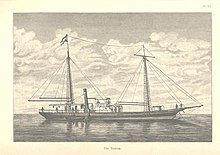Samoa (ship, 1883)

The Samoa was a steamship that played a significant historical role in Germany's contribution to the political race to colonize the South Seas .
Ship data
It was launched in March 1883 in the fishing village of Tomakin in the British colony of New South Wales in Australia as Sophia Ann . The wooden, copper-plated steamer with auxiliary sails was built by the W. Peat shipyard. The ship had 112 gross tons and was 37 meters long. A steam engine with 35 HP from R&J served as an additional drive for the two-master . Morrison & Bearley.
On July 11, 1884, the " German Trade and Plantation Society of the South Sea Islands in Hamburg" bought the ship, renamed it Samoa and had it registered in Hamburg. The captain was the Antarctic researcher and discoverer Eduard Dallmann , and first helmsman Hinrich Sechstroh. The first machinist was also brought from Hamburg. The remaining 14 sailors were hired in Sydney. With the exception of one Danish sailor, all crew members were Germans in Australia.
On July 27, 1885, while Dallmann's command was retained, the ship was sold to the banker and colonial entrepreneur Adolph von Hansemann in Berlin, then again to the New Guinea Company in Berlin on May 1, 1889 .
Samoa trips: The South Seas expedition under Finsch
On September 11, 1884, the ship left the port of Sydney. For camouflage reasons, the destination Phoenix Islands was incorrectly stated. In Sydney the ethnologist , ornithologist and agent of the German New Guinea Company Otto Finsch went on board as the alleged scientific leader of the expedition. Finsch had already arrived on July 29th, but the departure was delayed due to some renovation work, as the ship had to be converted into an expedition ship.
The Samoa was after a short time by two German warships SMS hyena , a gunboat commanded by Lieutenant Lange Mack, and SMS Elisabeth , a covered corvette under the command of Captain Rudolf Schering escorted.
The starting point of the Samoa voyages was the island of Mioko , part of the Duke of York Islands (Neu-Lauenburg from 1885 to 1919). The island is only 1.9 km² in size, but has a good natural harbor. The station there of the Deutsche Handels- und Plantagengesellschaft (DHPG) has therefore been an important basis for expeditions and the colonization efforts of the Hamburg trading houses Hernsheim and Godeffroy since 1875 .
On September 26th, the Imperial Commissioner for the New Britain Archipelago, Gustav von Oertzen , was taken on board off Mioko and set course for Astrolabe Bay . On November 27, 1884, the German flag was hoisted on the so-called “flag peninsula” in Finschhafen . On two trips along the northeast coast of New Guinea and the offshore islands, Finsch and von Oertzen negotiated contracts and letters of protection with the Papuan residents, which formed the basis for the proclamation of the German New Guinea protected area from Kaiser-Wilhelms-Land and the Bismarck Archipelago . At least Finsch was aware that the Papuans would understand neither the contracts with his trading company nor with the German Reich.
At the end of the fifth and last voyage to Samoa on May 28, 1885, Samoa had covered 5,000 nautical miles . In addition to numerous geographical, botanical and ethnological findings, these trips also brought significant, albeit controversial, territorial gains for the German Empire in the Melanesian part of Oceania .
After considerable diplomatic resentment between Germany and Great Britain, the British Colonial Minister finally gave in and recognized German New Guinea as a colony of the empire.
As a result of the occupation, Northeast New Guinea became part of the German protected areas in the South Seas until the Versailles Treaty .
Misfortune before Ballina
After the expeditions were over, the Samoa was sold to an Australian shipping company . On April 11, 1908, the steamer, renamed Sophia Ann , ran aground off Ballina on the Australian coast. The rushed tug Rescue was still able to moor the Sophia Ann , but then ran aground herself. Both ships ended in total loss.
Web links
Individual evidence
- ↑ Otto Finsch: Samoa rides. Travels in Kaiser-Wilhelms-Land and English New Guinea in 1884 and 1885 on board the German steamer Samoa. Verlag Hirt, Leipzig 1888, p. 6 .
- ↑ a b Otto Finsch: Samoa trips. Travels in Kaiser-Wilhelms-Land and English New Guinea in 1884 and 1885 on board the German steamer Samoa. Hirt publishing house, Leipzig 1888
- ^ Hans-Jürgen Ohff: Disastrous Ventures: German and British Enterprises in East New Guinea. Plenum Publishing Australia, Melbourne, 2015
- ↑ http://www.shipstamps.co.uk/forum/viewtopic.php?f=2&t=6746
- ↑ From 1884 classified as a cruiser frigate .
- ↑ Copy of Finsch's communication, contained in: Comité der Neuguinea-Kompagnie to Bismarck, March 21, 1885, file R1001-2800 of the colonial department of the Foreign Office, Federal Archives Berlin-Lichterfelde.
- ^ Hans-Jürgen Ohff: Disastrous Ventures: German and British Enterprises in East New Guinea. Plenum Publishing Australia, Melbourne, 2015
- ↑ Krauß: German New Guinea , in: Heinrich Schnee (ed.): Deutsches Kolonial-Lexikon , Volume 1, Quelle & Meyer, Leipzig, 1920, p. 315 ff.
- ^ R. Linke: The influence of German surveying on the development of New Guinea , 2006 Association of Surveyors of PNG . Retrieved October 22, 2015, in English.
- ^ Northern Star Newspaper , Lismore, Australia, April 11, 1908
